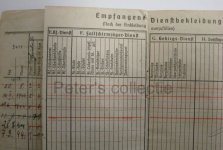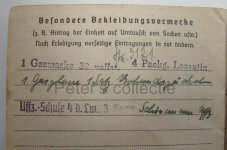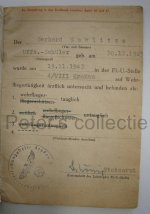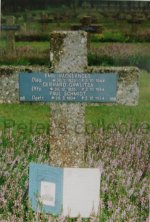Hello,
This is another new addition to my Soldbuch collection.
Gerhard Gawlitza was born on 30 December 1925 in Ratibov near Oppeln (Prussia), now the town is a part of Poland; he lived and worked as an apprentice mechanic in his hometown where his father was a local policeman.
In the summer of 1943, when he is 17 ½ year old, he volunteers for the Luftwaffe and on August 19 1943 he enters in to military service as a NCO student in the “Uffz Schule 4 der Luftwaffe”, this NCO school was formed in 1943 in Neusandez near Krakau.
On November 19 1943 he is medically tested and declared fit to become a military aviator.
- While Gerhard Gawlitza is attending classes in the NCO school the allies breakthrough the German frontline on the western front, when on September 4 1944 the allies liberate Antwerp a dangerous gap arises in the German frontline along the Albert canal; to close this gap and to halt the allied advance the newly created 1st Falschirmarmee under command of General Kurt Student is sent to the frontline; this newly created army is a Paratrooper army only in name, only FJR6 & I/FJR2 are real paratroop units, the main part of the army are new/young recruits from LW training units, Gerhard Gawlitza is one of them.
After a bit more then a year in NCO school he is promoted to Gefreiter/Unteroffizier-Anwärter, corporal/NCO aspirant on September 1 1944 on the same day he is assigned to replacement division of the newly created 1st Fallschirmarmee.
The next day he is transferred to the Ersatz (replacement) company of Fallschirmjäger Regiment 6 which is based in Stendal.
- On September 3 1944 FJR6 gets the order to move to Belgium, the troop trains leave the barrack camp in Germany the next day, they assemble in Tilburg (Holland) and early in the morning of September 8 1944 they march to the frontline in Northern Belgium.
Gerhard Gawlitza equipment is checked on September 7 1944.
Now his story is a bit of a mystery, although he is KIA fighting with the II/FJR6, there is no transfer listed to this active combat unit of FJR6. Was Gerhard Gawlitza with FJR6 on the frontline from the first day, September 8 1944, or was he assigned to them in a later stage?... I don’t know.
- In September ‘44 FJR6 is in the thick of the fighting in Belgium and Holland, they plug holes in the frontline, halt the allied advance of the Market-Garden operation, cut the corridor that is established in Holland,….etc; at the end of September ’44 FJR6 really needs a time out, which they get in the first days of October when they are pulled back from the frontline for a week. But on September 30 1944 the second battalion of FJR6 gets the urgent order to move south as soon as possible, the allies have broken through the frontline in Merksplas (Belgium) in the sector of the 719ID and II/FJR6 has to halt this breakthrough, it is in this battle that Gerhard Gawlitza will be KIA.
The soldiers of II/FJR6 are transported with trucks, together with the Panzerjager unit of the 719ID they create a defensive position in the hamlet Zondereigen (a two road town on the Dutch-Belgian border), their they stop the advance of the 1st Polish Armoured Division.
The fierce battle will rage three full days!
On the German war graves website Gerhard Gawlitza is listed as being KIA on October 1 1944, the first day of the battle in Zondereigen, but on his grave it is mentioned that he was KIA on October 3 1944, the last day of the battle.
He is buried in a communal grave, which is rather rare for Belgium.
The two other soldiers that are buried with him are: + 10/3/1944 Oberjäger Emil Hackländer, Oberjäger is a NCO rank for paratroopers so he was most likely an old sweat of FJR6 and + 10/2/1944 Obergefreiter Paul Schmidt, a 40 year old soldier, to old to be a paratrooper, so he was most likely a member of the 719ID, a unit with older soldiers.
How did this Soldbuch survived the war and ended up in my collection?
This Soldbuch was initially bought by a friend of me many years ago from ebay.de, so it isn’t very likely that it was an allied war souvenir.
Normally Soldbucher of KIA soldiers aren’t sent to the family; when a German soldier gets KIA and his Soldbuch is retrieved it is closed and put in his personal file.
This didn’t happen in this case, his Soldbuch wasn’t closed.
What did happen then? I don’t know, but someone did send it to Germany; perhaps by a comrade of him that took it out of his pocket or pack after he was KIA?
Enjoy the images,
Peter
This is another new addition to my Soldbuch collection.
Gerhard Gawlitza was born on 30 December 1925 in Ratibov near Oppeln (Prussia), now the town is a part of Poland; he lived and worked as an apprentice mechanic in his hometown where his father was a local policeman.
In the summer of 1943, when he is 17 ½ year old, he volunteers for the Luftwaffe and on August 19 1943 he enters in to military service as a NCO student in the “Uffz Schule 4 der Luftwaffe”, this NCO school was formed in 1943 in Neusandez near Krakau.
On November 19 1943 he is medically tested and declared fit to become a military aviator.
- While Gerhard Gawlitza is attending classes in the NCO school the allies breakthrough the German frontline on the western front, when on September 4 1944 the allies liberate Antwerp a dangerous gap arises in the German frontline along the Albert canal; to close this gap and to halt the allied advance the newly created 1st Falschirmarmee under command of General Kurt Student is sent to the frontline; this newly created army is a Paratrooper army only in name, only FJR6 & I/FJR2 are real paratroop units, the main part of the army are new/young recruits from LW training units, Gerhard Gawlitza is one of them.
After a bit more then a year in NCO school he is promoted to Gefreiter/Unteroffizier-Anwärter, corporal/NCO aspirant on September 1 1944 on the same day he is assigned to replacement division of the newly created 1st Fallschirmarmee.
The next day he is transferred to the Ersatz (replacement) company of Fallschirmjäger Regiment 6 which is based in Stendal.
- On September 3 1944 FJR6 gets the order to move to Belgium, the troop trains leave the barrack camp in Germany the next day, they assemble in Tilburg (Holland) and early in the morning of September 8 1944 they march to the frontline in Northern Belgium.
Gerhard Gawlitza equipment is checked on September 7 1944.
Now his story is a bit of a mystery, although he is KIA fighting with the II/FJR6, there is no transfer listed to this active combat unit of FJR6. Was Gerhard Gawlitza with FJR6 on the frontline from the first day, September 8 1944, or was he assigned to them in a later stage?... I don’t know.
- In September ‘44 FJR6 is in the thick of the fighting in Belgium and Holland, they plug holes in the frontline, halt the allied advance of the Market-Garden operation, cut the corridor that is established in Holland,….etc; at the end of September ’44 FJR6 really needs a time out, which they get in the first days of October when they are pulled back from the frontline for a week. But on September 30 1944 the second battalion of FJR6 gets the urgent order to move south as soon as possible, the allies have broken through the frontline in Merksplas (Belgium) in the sector of the 719ID and II/FJR6 has to halt this breakthrough, it is in this battle that Gerhard Gawlitza will be KIA.
The soldiers of II/FJR6 are transported with trucks, together with the Panzerjager unit of the 719ID they create a defensive position in the hamlet Zondereigen (a two road town on the Dutch-Belgian border), their they stop the advance of the 1st Polish Armoured Division.
The fierce battle will rage three full days!
On the German war graves website Gerhard Gawlitza is listed as being KIA on October 1 1944, the first day of the battle in Zondereigen, but on his grave it is mentioned that he was KIA on October 3 1944, the last day of the battle.
He is buried in a communal grave, which is rather rare for Belgium.
The two other soldiers that are buried with him are: + 10/3/1944 Oberjäger Emil Hackländer, Oberjäger is a NCO rank for paratroopers so he was most likely an old sweat of FJR6 and + 10/2/1944 Obergefreiter Paul Schmidt, a 40 year old soldier, to old to be a paratrooper, so he was most likely a member of the 719ID, a unit with older soldiers.
How did this Soldbuch survived the war and ended up in my collection?
This Soldbuch was initially bought by a friend of me many years ago from ebay.de, so it isn’t very likely that it was an allied war souvenir.
Normally Soldbucher of KIA soldiers aren’t sent to the family; when a German soldier gets KIA and his Soldbuch is retrieved it is closed and put in his personal file.
This didn’t happen in this case, his Soldbuch wasn’t closed.
What did happen then? I don’t know, but someone did send it to Germany; perhaps by a comrade of him that took it out of his pocket or pack after he was KIA?
Enjoy the images,
Peter
Attachments
-
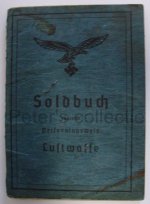 DSC05206.jpg94.1 KB · Views: 21
DSC05206.jpg94.1 KB · Views: 21 -
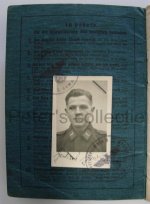 DSC05207.jpg104.2 KB · Views: 26
DSC05207.jpg104.2 KB · Views: 26 -
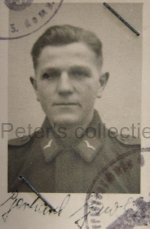 DSC05208.jpg76.6 KB · Views: 27
DSC05208.jpg76.6 KB · Views: 27 -
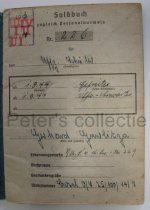 DSC05209.jpg104.9 KB · Views: 21
DSC05209.jpg104.9 KB · Views: 21 -
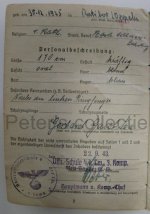 DSC05210.jpg108.1 KB · Views: 22
DSC05210.jpg108.1 KB · Views: 22 -
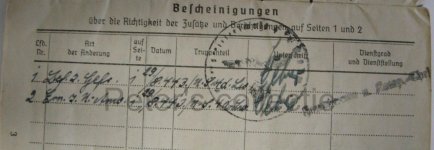 DSC05211.jpg82.7 KB · Views: 17
DSC05211.jpg82.7 KB · Views: 17 -
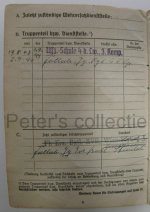 DSC05212.jpg108.1 KB · Views: 19
DSC05212.jpg108.1 KB · Views: 19 -
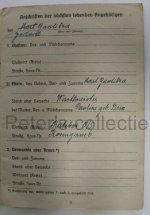 DSC05213.jpg104 KB · Views: 17
DSC05213.jpg104 KB · Views: 17 -
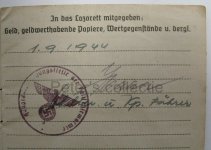 DSC05214.jpg158.9 KB · Views: 16
DSC05214.jpg158.9 KB · Views: 16 -
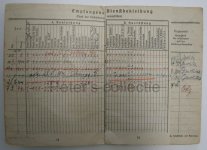 DSC05215.jpg206.8 KB · Views: 20
DSC05215.jpg206.8 KB · Views: 20



